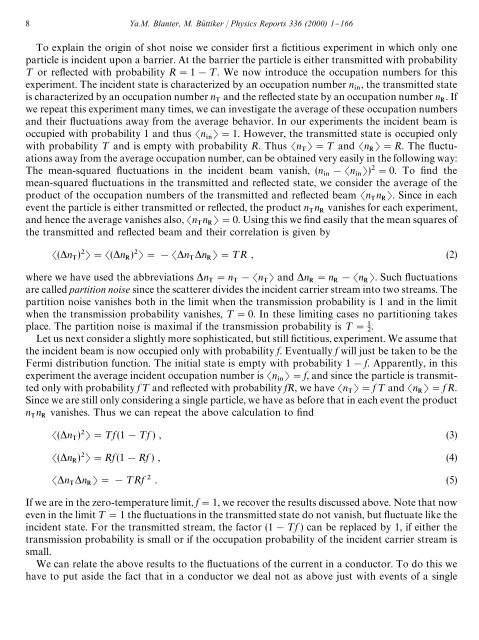shot noise in mesoscopic conductors - Low Temperature Laboratory
shot noise in mesoscopic conductors - Low Temperature Laboratory
shot noise in mesoscopic conductors - Low Temperature Laboratory
You also want an ePaper? Increase the reach of your titles
YUMPU automatically turns print PDFs into web optimized ePapers that Google loves.
8 Ya.M. Blanter, M. Bu( ttiker / Physics Reports 336 (2000) 1}166<br />
To expla<strong>in</strong> the orig<strong>in</strong> of <strong>shot</strong> <strong>noise</strong> we consider "rst a "ctitious experiment <strong>in</strong> which only one<br />
particle is <strong>in</strong>cident upon a barrier. At the barrier the particle is either transmitted with probability<br />
¹ or re#ected with probability R"1!¹. We now <strong>in</strong>troduce the occupation numbers for this<br />
experiment. The <strong>in</strong>cident state is characterized by an occupation number n , the transmitted state<br />
is characterized by an occupation number n and the re#ected state by an occupation number n .If<br />
we repeat this experiment many times, we can <strong>in</strong>vestigate the average of these occupation numbers<br />
and their #uctuations away from the average behavior. In our experiments the <strong>in</strong>cident beam is<br />
occupied with probability 1 and thus n "1. However, the transmitted state is occupied only<br />
with probability ¹ and is empty with probability R. Thus n "¹ and n "R. The#uctuations<br />
away from the average occupation number, can be obta<strong>in</strong>ed very easily <strong>in</strong> the follow<strong>in</strong>g way:<br />
The mean-squared #uctuations <strong>in</strong> the <strong>in</strong>cident beam vanish, (n !n )"0. To "nd the<br />
mean-squared #uctuations <strong>in</strong> the transmitted and re#ected state, we consider the average of the<br />
product of the occupation numbers of the transmitted and re#ected beam n n . S<strong>in</strong>ce <strong>in</strong> each<br />
event the particle is either transmitted or re#ected, the product n n vanishes for each experiment,<br />
and hence the average vanishes also, n n "0. Us<strong>in</strong>g this we "nd easily that the mean squares of<br />
the transmitted and re#ected beam and their correlation is given by<br />
(n )"(n )"!n n "¹R , (2)<br />
where we have used the abbreviations n "n !n and n "n !n . Such #uctuations<br />
are called partition <strong>noise</strong> s<strong>in</strong>ce the scatterer divides the <strong>in</strong>cident carrier stream <strong>in</strong>to two streams. The<br />
partition <strong>noise</strong> vanishes both <strong>in</strong> the limit when the transmission probability is 1 and <strong>in</strong> the limit<br />
when the transmission probability vanishes, ¹"0. In these limit<strong>in</strong>g cases no partition<strong>in</strong>g takes<br />
place. The partition <strong>noise</strong> is maximal if the transmission probability is ¹" .<br />
Let us next consider a slightly more sophisticated, but still "ctitious, experiment. We assume that<br />
the <strong>in</strong>cident beam is now occupied only with probability f. Eventually f will just be taken to be the<br />
Fermi distribution function. The <strong>in</strong>itial state is empty with probability 1!f. Apparently, <strong>in</strong> this<br />
experiment the average <strong>in</strong>cident occupation number is n "f, and s<strong>in</strong>ce the particle is transmitted<br />
only with probability f ¹ and re#ected with probability fR, we have n "f ¹ and n "fR.<br />
S<strong>in</strong>ce we are still only consider<strong>in</strong>g a s<strong>in</strong>gle particle, we have as before that <strong>in</strong> each event the product<br />
n n vanishes. Thus we can repeat the above calculation to "nd<br />
(n )"¹f (1!¹f ) , (3)<br />
(n )"Rf (1!Rf ) , (4)<br />
n n "!¹Rf . (5)<br />
If we are <strong>in</strong> the zero-temperature limit, f"1, we recover the results discussed above. Note that now<br />
even <strong>in</strong> the limit ¹"1 the #uctuations <strong>in</strong> the transmitted state do not vanish, but #uctuate like the<br />
<strong>in</strong>cident state. For the transmitted stream, the factor (1!¹f ) can be replaced by 1, if either the<br />
transmission probability is small or if the occupation probability of the <strong>in</strong>cident carrier stream is<br />
small.<br />
We can relate the above results to the #uctuations of the current <strong>in</strong> a conductor. To do this we<br />
have to put aside the fact that <strong>in</strong> a conductor we deal not as above just with events of a s<strong>in</strong>gle
















